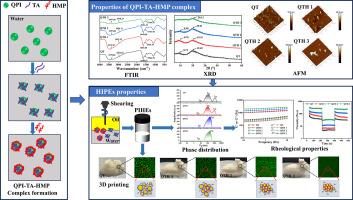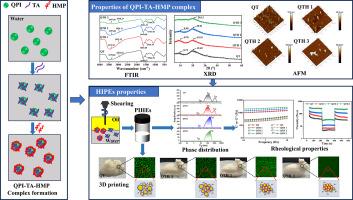高甲氧基果胶调节藜麦分离蛋白-单宁酸复合物通过非共价相互作用稳定高内相乳液,增强3d打印食品
IF 9.8
1区 农林科学
Q1 CHEMISTRY, APPLIED
引用次数: 0
摘要
本研究研究了藜麦分离蛋白(QPI)、单宁酸(TA)和高甲氧基果胶(HMP)三元配合物的形成机制,同时探索了稳定的高内相乳剂(HIPEs)在3d打印食品中的应用潜力。结果表明,QPI-TA (QT)配合物与HMP主要通过疏水相互作用、氢键和静电力形成QPI-TA-HMP (QTH)三元配合物。通过调整QT与HMP的比例,可以获得在宽pH范围内具有高稳定性和zeta电位的QTH配合物。用QTH配合物制备的HIPEs具有油滴直径小、硬度、回弹性和力学性能高等特点,具有适合食用油墨应用的理化特性。这是通过使用HIPEs作为3D打印食物模型的可食用墨水来验证的。本研究促进了三元生物聚合物配合物作为乳化剂的合理设计,并为食品油墨的发展提供了有价值的见解。本文章由计算机程序翻译,如有差异,请以英文原文为准。


High methoxy pectin regulates quinoa protein isolate-tannic acid complex to stabilized high internal phase emulsion via non-covalent interactions for enhanced 3D-printed foods
This study investigates the formation mechanism of the quinoa protein isolate (QPI), tannic acid (TA), and high methoxyl pectin (HMP) ternary complex, while exploring the potential of stable high internal phase emulsions (HIPEs) in 3D-printed food applications. The results indicate that QPI-TA (QT) complex and HMP primarily form the QPI-TA-HMP (QTH) ternary complex through hydrophobic interactions, hydrogen bonding, and electrostatic forces. By adjusting the ratio of QT to HMP, QTH complexes with high stability and zeta potential across a wide pH range can be achieved. HIPEs prepared with QTH complexes exhibit smaller oil droplet diameters, high hardness, resilience and mechanical properties, suggesting that they possess physiochemical characteristics suitable for edible ink applications. This was validated by using the HIPEs as edible inks to 3D print model food objects. This study advances the rational design of ternary biopolymer complexes as emulsifiers and offers valuable insights into the development of food inks.
求助全文
通过发布文献求助,成功后即可免费获取论文全文。
去求助
来源期刊

Food Chemistry
工程技术-食品科技
CiteScore
16.30
自引率
10.20%
发文量
3130
审稿时长
122 days
期刊介绍:
Food Chemistry publishes original research papers dealing with the advancement of the chemistry and biochemistry of foods or the analytical methods/ approach used. All papers should focus on the novelty of the research carried out.
 求助内容:
求助内容: 应助结果提醒方式:
应助结果提醒方式:


